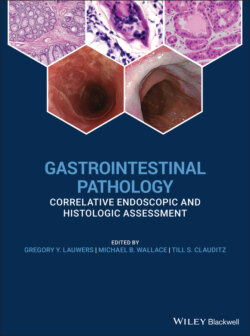Читать книгу Gastrointestinal Pathology - Группа авторов - Страница 58
Microscopic Features
ОглавлениеThe typical features of GERD are basal cell layer hyperplasia, papillary elongation, dilated intercellular spaces (intercellular edema/spongiosis), and intraepithelial inflammation, including neutrophils, eosinophils, and mononuclear cells (Table 2.2; Figures 2.10, 2.11). However, none of these features is specific for this diagnosis.
The proliferative epithelial changes are more common than inflammatory infiltration. Basal cell hyperplasia is diagnosed when the thickness of the basal layer exceeds 15% in a well‐oriented section. Papillary elongation, defined as extending >50% of the epithelial thickness, should also be only assessed in well‐oriented sections. Finally, in minimal GERD, dilated intercellular spaces in the basal and parabasal areas may be the only finding.
Esophageal squamous mucosa normally contains few or no inflammatory cells and the inflammatory infiltrate in GERD is highly variable. The presence of occasional eosinophils is typical of GERD, although large numbers of intraepithelial eosinophils mimicking eosinophilic esophagitis may be identified. Notably, eosinophils are not found in all GERD biopsies and can be seen in asymptomatic patients. Neutrophils may be present, and are more numerous in areas of erosion and ulceration. Lymphocytes, often with irregular nuclear contours (squiggle cells), are usually scattered through the epithelium. Finally, severe inflammation with ulceration may be associated with inflammatory pseudotumor formation, with marked atypia of the reactive stromal cells.
Table 2.2 Histologic features of GERD.
| Basal cell hyperplasia (>15%) |
| Papillary elongation (>50%) |
| Dilated intercellular spaces (spongiosis) |
| Intraepithelial inflammation Neutrophils |
| Eosinophils |
| Mononuclear cells |
Figure 2.10 Characteristic appearance of low‐power view of reflux esophagitis with basal cell hyperplasia, elongation of papillae, lymphocytic and eosinophilic infiltrate.
In practice, the report should provide a descriptive summary of the histologic features and injury patterns present, as well as their severity. A note can be added to state that the findings are compatible with reflux injury pattern in the appropriate clinical setting.
Figure 2.11 High‐power magnification of reflux esophagitis with basal cell hyperplasia, spongiosis, and eosinophilic infiltrate.
